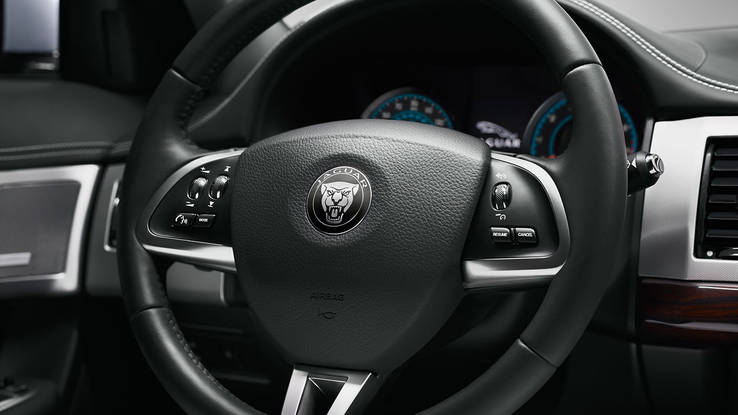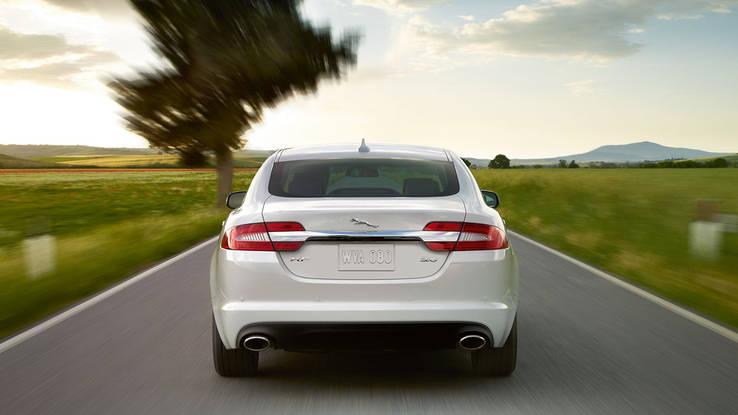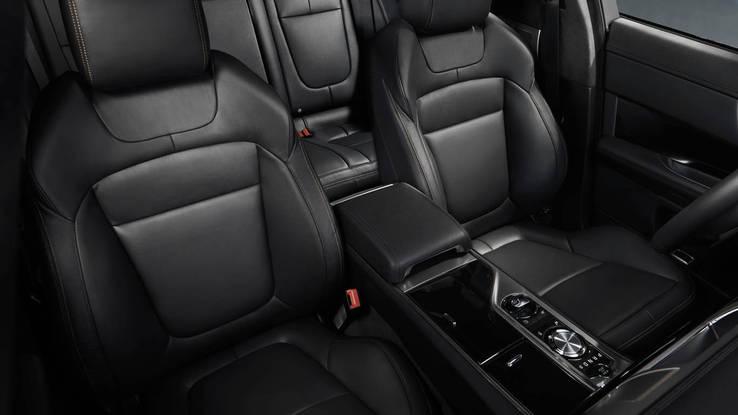Jag preps its next front against established German sedan rivals
What is it?
Pitched against the 5-Series/A6/E-Class luxury set, the second-generation Jaguar XF 35t and S introduce the company’s aluminum-intensive platform to North America for the first time.
The platform is shared with the upcoming F-Pace SUV, splits approximately 75/25 percent aluminum/steel and uses double-wishbone front/multilink “Integral Link” rear suspension. The XF is up to 265 pounds lighter than its all-steel V6 predecessor, torsional stiffness rises 28 percent and there’s near 50/50 weight distribution — though upcoming four-cylinder models get closest to the latter.
Slimmed down, the modular architecture is also shared with Jaguar’s XE 3-Series rival. Jaguar launched the XE before the XF in Europe earlier this year, but delayed its North America debut until the 2017 model year when all-wheel drive bows. The XF goes on sale with both rear- and all-wheel drive starting this fall, leapfrogging its slightly older and smaller sibling into U.S. dealer showrooms.
Prices start from $ 51,900 for the 35t, $ 62,700 for S, and the 2.0D four-cylinder turbodiesel drops the price “significantly below” $ 50K when it arrives in mid-2016, Jag says.
Autoweek got an early drive in the XF 2.0D last month, but this is our first shot in the 35t and S. Both use the same 3.0-liter, direct-injection supercharged V6 as the F-type, come in 340-hp and 380-hp versions, and shift with an eight-speed paddleshift auto.
We tested the 340-hp 35t on Spanish autoroutes and mountain roads, the all-wheel-drive S on Circuito de Navarra.

XF 3-spoke steering wheel with Jaguar Sequential Shift.
What’s it like to drive?
The XF’s refinement on autoroutes impressed us. Our 35t test car had optional adaptive dampers (standard for S) and lulling, well-controlled vertical movements characterized the supple ride at 70 mph — it’s more pillowy than the 2.0D Sport’s passive dampers, that set-up being is special order only in the U.S.
Wind- and road noise are well contained and the smooth V6 emits a characterful part-throttle warble. Accelerate and the eight-speed auto drops gears quickly and smoothly while the flexible V6 builds speed with respectable urgency, without the F-Type’s rowdy aural drama.
Overall, it’s well suited for the luxury sedan market, and a nice companion for a few hours’ steady-state cruising.
Stray off the main routes and into the mountains and the Jag’s personality shifts, especially if you switch to dynamic mode; it firms the adaptive suspension, ups steering weight and increases throttle response.
The sharper throttle is particularly noticeable: on and off the gas through corners, the accelerator responds with crispness, heightening the connection between driver and car. Keep the throttle pinned, and you find this a fast — if not seriously quick — machine.
Use the paddleshifters if you wish — an engineered-in thunk of engagement indicates the changes are getting “dynamic” — but they’re last-gen cheap to the touch and S mode is basically psychic; no shame in admitting the electronics are better than you.
In either mode, the steering has more weight than the first-gen XF, and does dynamic without straying into the under-assisted stickiness that defines sportier German settings. The helm’s fast, accurate, and nicely weighted, though lacks the old hydraulic rack’s feel; Jag cites the electrically assisted system’s 3-percent fuel saving as recompense.
Thread together corners and you’re unaware of any ride-quality deterioration. Instead, those leisurely vertical movements become more quickly curtailed and the body remains highly composed, flicking from apex to apex. Again the composure and responsiveness stands out, especially through fast direction changes; the XF’s front end follows steering inputs like a puppy trying to outwit its reflection.

The 2015 Jaguar XF 35t and S AWD go on sale this fall.
When we drove the XF 2.0D, we said it didn’t quite have the XE’s agility because it didn’t have the power to truly work the chassis. The V6-powered 35t solves this, but only partially. Yes there’s that satisfying feeling when the rear end guides you through corners, though it’s not tail-happy, and you feel the extra weight over the nose from two extra cylinders — the front pushes wide if you lean on it as hard as you can in the XE. In fact, we’d say the XF 2.0D has the sharper front end, so you need patience in slow- to mid-speed corners.
The 20D’s weight distribution with the V6’s is the impossible sweet spot based on our drives so far. In the achievable world, it’s the smaller XE 3.0 V6 that’s the more enjoyable, sharper steer.
Of course, the XF is a larger, less wieldy package and the payback is far more rear-seat room than both XE and the last-gen XF. That’s despite the XF being a quarter-inch shorter and an eighth of an inch lower than its predecessor. Clever packaging and a 2-inch wheelbase-stretch equals an inch more kneeroom, a half-inch more legroom, and an inch extra headroom. It’s a comfortable place for 6-foot-tall adults to spend a long journey.
On the racetrack in the 380-hp S, the midrange performance immediately feels fuller, more flexible, and more than the 40-hp bonus might suggest. And that’s even with an extra 110 pounds from this car’s all-wheel drive. It’s an updated system compared with even the just-launched F-Type AWD, switching from gears to chain drive; it’s 16 percent lighter and 10 percent more efficient. Quieter too, says Jag.
The AWD S retains a rear-drive feel through faster turns, and proves even more adjustable than the F-Type, due to a longer wheelbase and softer suspension. It’s not wild, just satisfying, and it means you can point the nose at the apex with little lifts off the throttle.
Accelerate hard from slower corners and you feel the car working hard, pulling you forward and, yes, feeling some understeer; impressively, steering corruption is minimal. On a wet-handling circuit, the all-wheel-drive V6 proved sure-footed, if ultimately a gently stubborn understeerer. Not so much fun, but capable and sure-footed in tricky conditions.

The luxurious XF cabin is both spacious and sporty.
Do I want it?
There’s a lot to recommend the new XF 35t and S models: on adaptive suspension they’re smooth, refined and comfortable, all matched to a silky powertrain that suits this luxury sedan far better than the comparatively uncultured 2.0D we first tried.
The new XF is also a significant step over its predecessor when it comes to rear-seat accommodation: what was once marginal and cramped is now spacious and airy.
Switch to dynamic mode and the XF is an engaging, enjoyable steer on a challenging road. It might lack the XE’s outright poise, but it’s still fun and proves more involving than its German opposition. That’s important. Our choice? A rear-drive 3.0 V6 S.




























